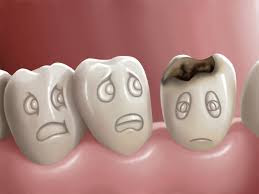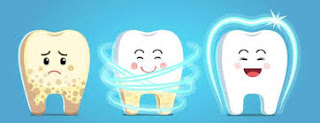Know about tooth decay stages in detail.
Decay affects both the enamel and the dentin layer of the tooth. The plaque bacteria generate acidic by-products that eat away at the enamel, slowly creating holes in the teeth known as dental cavities. There are different stages of tooth decay.
White Spots
In the starting stage of tooth decay begins when chalky white areas on the surface of the tooth appears due to the loss of calcium and the build-up of plaque. Bacteria in the plaque then starts to metabolize sugars from food consumed. These white spots are illustrative of the demineralization of the tooth and can be easy to miss because they’re likely to occur on your kind molars. In this stage, tooth decay might still be reversible with the proper procedure-which should be discussed with your dentist, such as using a fluoride toothpaste, and applying a topical fluoride treatment.
Enamel Decay
In the second stage of tooth decay, the enamel starts attack underneath the tooth’s surface. At this stage, the natural remineralization process is not able to restore the proper enamel and minerals, causing a lesion to form within the tooth. Once the cavity breaks through the surface of the enamel, there is no turning back. Your child will need to have the cavity corrected with a filling.
Dentin Decay
If a cavity in your kids’ mouth were to progress beyond stage two without you knowing. You did tend to become aware of it when it began to hit stage 3 because it would most likely begin to cause pain. At this level, the cavity starts to consume the 2nd level of tooth material that lies underneath the enamel: the dentin. when the cavity moves to the dentin, the level of pain begins to intensify and sharp pain may be experienced in the infected tooth. At this point, a dental filling will most likely be required to reestablish the tooth.
Involvement of The Pulp
Once the cavity reaches in the pulp, it will hurt. If the pulp of a tooth gets infected with microorganisms, it harmed the blood vessels and nerves in the tooth. This is generally known as a toothache and can cause constant pain. At this stage, a root canal is the only option of treatment, save for a complete extraction.
Abscess Formation
In this stage of tooth decay, infection has reached the tip of the root and exited the tip of the tooth’s structure. This, in turn, infects the encompassing tissues and possibly the bone structure. The gums often swell which can affect speech and puts you at risk for more diseases. Root canal or extraction would be the order of the day should decay arrive at this stage.
Whenever left untreated at each stage of tooth decay, the tooth will be lost and it must be removed. Smith and Cole dentistry provides you all dental care services with high-quality dental techniques. Contact us for any consultation or appointment booking.




Comments
Post a Comment